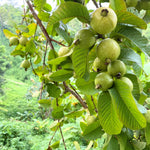Prenumerera och spara 10%!

Guava 'Ki Nok' (Psidium guajava)
45 kr
Unit price perFörväntat leveransdatum: 12 January till 19 January.
Gäller beställningar inom Sverige. För övriga länder - se våra leveransvillkor.
Share
SEEDS (20pcs/bag)
Common names: Guava, Guajava, Guayava, Yellow Guava
Scientific name: Psidium guajava
Family: Myrtaceae
Plant history & use:
Guava is a tropical fruit tree that originally comes from Central and South America. The variety 'Ki Nok' is a variety that has arisen in Southeast Asia with abundant production of smaller fruits, about 6-7 cm in diameter. The outer skin of the fruit changes from green to yellow when ripe and so does the pulp. The fruits can also be eaten when they are green and then have a more crunchy texture - in Asia, the green fruits sliced into wedges are dipped in a mixture of sugar, salt and chili - unexpectedly delicious.
The fascinating thing about the guava fruit is that it has two different "layers" with different flavors. The outermost layer (including the shell and a few centimeters in) tastes slightly "barry", while the innermost layer tastes tropical and sweet. The taste can be described as a mixture between pear, mango & strawberry for those who have not tasted Guava before. The outermost layer, including the flavor, decreases in thickness as the fruit ripens.
The tree can grow up to 30 meters high.
Guava is a rich source of vitamin C and other antioxidants. The fruits are usually eaten fresh or used to make juice, jam and jelly.
The bark of a guava tree has a smooth mottled appearance, with parts of the bark peeling off at different times and in different places. It creates a beautiful pattern and contributes to a highly decorative appearance in the cultivation.
Another beautiful feature of the guava tree is its flowers, which are large, white and fragrant. These flowers are attractive to both insects and birds, which can help bring life to the garden.
Culture:
Guava is a hardy and easy-to-grow plant that can be grown in a wide range of soils. However, it prefers a well-drained, sandy soil with a pH level between 6 and 7. Guava thrives best in a warm climate with high temperatures and high humidity, but can also tolerate lower temperatures down to the freezing point. Cultivation in a greenhouse is therefore preferable, alternatively frost-free wintering.
The plant position is important for guava, the tree thrives best in full sun or partial shade. But it is important to ensure that the tree does not receive too much direct sunlight during the hottest hours of the day, otherwise it can cause damage to the leaves and fruit.
Guava is a drought-resistant plant and can cope with long periods without water. But for best fruit production, the soil should be kept moist and fertilized regularly with a balanced fertilizer. It is also important to prune the tree regularly to control size and to promote fruit production.
The time span for harvest varies depending on the plant's growing conditions, but guava trees are usually ready for harvest after 2-3 years from planting. However, it can take up to five years for some trees to start producing fruit. Fruiting period is between June and October.
Sowing:
Guava seeds are best grown in pots.
Place the seeds on moist sowing soil and cover them with a thin layer of soil. Keep the soil moist and place the pot in a warm, sunny location. Cover the pot with a plastic bag or a glass cup to create a mini drive bench.
Germination usually takes between two to six weeks. When the plants are large enough to handle, replant them in larger pots or in the ground in greenhouses.
It is important to ensure that the plants do not become dehydrated during the first growing season, but avoid at the same time overwatering as it can cause rot and kill the plants. The guava tree is known to be a hardy plant, but it is important to take good care of the seed for effective germination.
Characteristics:
Age: Perennial
Plant position: sun / partial shade
Height: 3-30 meters
Germination time: 2-6 weeks
- Choosing a selection results in a full page refresh.
- Opens in a new window.








